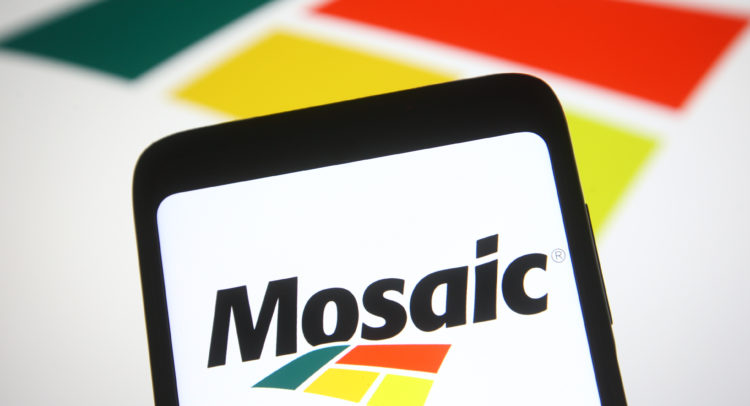I am bullish on The Mosaic Company (MOS).
Claim 50% Off TipRanks Premium and Invest with Confidence
- Unlock hedge-fund level data and powerful investing tools designed to help you make smarter, sharper decisions
- Stay ahead of the market with the latest news and analysis so your portfolio is always positioned for maximum potential
The crisis in Eastern Europe has had a significant impact on the performance of basic materials stocks so far, with the Materials Select Sector SPDR Fund (XLB), the benchmark index that measures their overall performance, falling 6% year-to-date.
The disruption in the supply of various materials and goods due to the war in Ukraine has also caused major logistical problems, affecting the regular shipments of many providers of basic materials. That’s essentially why the sector has performed poorly so far.
However, there are exceptions among basic materials stocks.
One such stock is The Mosaic Company, whose shares are up 49.4% this year despite rising inflation, the war in Ukraine, and recession fears.
The market continues to have confidence in Mosaic and considers its business strong enough to weather all of the uncertainties, worries, and difficulties of this economy.
A testament to that strength is the company’s most recent quarterly results, presented here after a brief description of the company.
About Mosaic Co
The Mosaic Company is a full-line supplier of phosphate and potash fertilizers and feed ingredients to the global agricultural industry.
Specifically, the company mines phosphate to produce crop nutrients and animal feed ingredients, and it mines potash to produce blended crop nutrients and animal feed ingredients.
In addition, Mosaic provides nitrogen-based crop nutrients, animal feed ingredients, and other ancillary services.
The company’s customers are wholesalers, retailers, farmers, cooperatives, and national accounts.
Its headquarters are in Tampa, Florida.
Financial Results for the First Quarter of 2022
In the first quarter of 2022, the company managed to offset lower volumes with higher prices, allowing revenue to grow 71% year-over-year to $3.9 billion, roughly in line with Wall Street’s median forecast.

Adjusted net income was $2.41 per diluted share or 4.23 times higher year-over-year, also in line with analysts’ average estimate.
In addition, the company reported the following improvements: adjusted EBITDA increased 159% year-over-year to $1.45 billion, and operating cash flow increased 58.8% to $506.2 million. The gross profit of $1.44 billion more than tripled from $435 million in the year-ago quarter.
The Potash segment accounted for 42.9% of adjusted EBITDA, while the Phosphate and Fertilizer segments accounted for 41.7% and 15.4%, respectively.
Near-Term Prospects
The war in Ukraine has led to, among other things, the destruction of infrastructure and the blocking of strategic hubs for transporting foodstuffs to different regions of the world. Target countries include those in Africa and other poor regions.
Also, elevated inflation is causing major commodity-producing countries to curb exports of various foodstuffs to control the rapid rise in prices of goods and services.
India is particularly noteworthy because it is the world’s largest producer and second-largest exporter of sugar after Brazil.
After the wheat blockade, the Indian government decided to try to calm down rampant inflation, which reached an annual rate of 7.8% in April, by limiting sugar exports and redirecting them to domestic ethanol production.
The geopolitical crisis in Eastern Europe and India’s export blockade could trigger a severe food crisis, particularly in African countries and the other poorest regions of the world.
A way to combat a food crisis is to significantly increase crop yields so these countries can have sufficient volumes of food. This could create an unprecedented demand for high-yielding crops.
Suffice to say, just the Sahel Region, where the catastrophic humanitarian crisis is threatening the lives of nearly three million people, covers over 3.05 million km² and crosses 11 countries from the Atlantic Ocean to the Red Sea.
Mosaic’s projects to increase nutrient and fertilizer production fit perfectly into this global geopolitical framework. The company has ramped up potash production at specific mines in Canada and expanded the operating capacity of its Colonsay facilities.
In 2022, the company plans to allocate approximately $400 million to increase the annual potash operating run rate (from 10.8 million tons in 2022 to 12.3 million tons in 2023) and increase the U.S. phosphate production by 1 million tons this year (about 59% of total finished phosphate production in 2021).
In the second quarter of 2022, the company expects to deliver between 1.9 million and 2.1 million tons of phosphate (vs. 2 million tons in Q2 2021) and between 2.4 million and 2.6 million tons of potash (vs. 2.3 million tons in Q2 2021).
Financial Health
With sales volume and average realized prices expected to trade higher over the upcoming quarters, the balance sheet should continue to improve. Therefore, the company should be able to cut its long-term debt ($3.38 billion as of March 30, 2022) by $1 billion before the end of 2022.
Should Mosaic be able to yield most of its free cash flow back to shareholders, its stock price could potentially rise quickly. About 99% of free cash flow was returned to shareholders in the first quarter through share buybacks and dividends.
Wall Street’s Take
In the past three months, 15 Wall Street analysts have issued a 12-month price target for MOS stock. The company has a Moderate Buy consensus rating based on seven Buys, seven Holds, and one Sell rating.
The average Mosaic Company price target is $74.14, implying 26.3% upside potential.

Valuation and Dividend
Shares are changing hands at $58.96 as of the writing of this article for a market cap of $21.2 billion and a 52-week range of $28.26 to $79.28.
Although the current market turbulence could lead to further price declines, the stock is already significantly cheaper for prospective buyers.
Currently, the stock is about 11% below its 50-day moving average of $65.63.
As of this writing, the stock offers a dividend yield of around 1%. Its quarterly dividend payment increased from $0.11 per share two quarters ago to $0.15 per share in the most recent quarter.
Conclusion
The war in Ukraine, geopolitical tensions, and elevated inflation are causing several problems on the commodities supply side.
In the event of a food crisis, which is very likely, Mosaic’s production expansion programs are a perfect fit with the need to increase production of higher-yielding crops, as this will offset supply shortages.
The globalization of transportation networks will support Mosaic in pursuing this goal.
Read full Disclosure
















